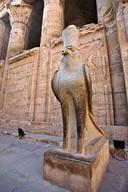A Brief History of Egypt
timeline

5000 B.C.E.
Farmers begin to plan crops along the Nile River.
4000 B.C.E.
City-states (nomes) are formed along the Nile. Two separate, large kingdoms form.
3100 B.C.E.
The two kingdoms are united by King Menes (aka Narmer). Hieroglyphs are invented.

Djoser or “step” pyramid
2700-2200 B.C.E.
Time of peace. Egyptians produce a lot of sculptures. In 2680 B.C.E. the first pyramid is constructed for King Djoser.
2200-2050 B.C.E.
Known as the "first intermediate period." The kingdom collapses.
2052-1800 B.C.E.
King Mentuhotep reunites the kingdoms in 2052 B.C.E. This period is known as the "middle kingdom." Thebes becomes the capital.
1800-1570 B.C.E.
Hyksos (barbarians from the north) conquer Lower Egypt in 1778. The time of their rule is the "second intermediate period."

Alexander the Great

Alexander the Great
1570-1090 B.C.E.
Egypt is reunited by King Ahmose. Known as the "new kingdom."
1090-332 B.C.E.
Egypt breaks into states once again.
332-30 B.C.E.
Alexander the Great invades in 332.
30 B.C.E.
Romans begin rule of Egypt.
To view The British Museum’s timeline, click here.
(http://www.ancientegypt.co.uk/time/explore/main.html)
agriculture and food

Papyrus
The flooding of the Nile was used to the Egyptians' advantage. They developed irrigation systems for their farming.
For planting, farmers often scattered seeds then used cattle and a plow to go over them. They then used goats or sheep to drive the seeds further into the ground.
Bread and beer were made from the barley Egyptians grew. Dates, figs, and other fruits were commonly eaten. Wealthy Egyptians could afford meat including antelope, oxen, gazelle, quail, and porcupines!
education
Most sons learned from their fathers. Girls were not trained as often as boys, and did not usually know how to write. Some boys attended what was known as "The House of Life" to learn how to become a scribe—to read and write.
religion

Egyptian god Orus in front of temple
Religion was an important part of Egyptian life. Egyptians worshipped the sun, and believed in many gods. They also believed in an afterlife. To find out more, go to our religion page.
sports and games
Most children played outside. Toys children played with include dolls, spinning tops, sticks. Some played a boardgame called "senet." Older male Egyptians would hunt, box, or wrestle.
transportation
 Boats were used to travel along the Nile. Most people used rafts, but the wealthier Egyptians used decorated boats.
Boats were used to travel along the Nile. Most people used rafts, but the wealthier Egyptians used decorated boats.
work
Besides working as farmers, Egyptians were also architects, metalworkers, painters, carpenters, jewelry makers, and bakers. Those with enough education held the honor of working as scribes.
references
The British Museum. (2010). A time line of ancient Egyptian history. Retrieved from
http://www.ancientegypt.co.uk/time/explore/main.html
Browne, E., et al. (2001). Ancient Egypt. Monkeyshines on ancient cultures, 37. Retrieved from Primary Search database.

Papyrus
education
religion

Egyptian god Orus in front of temple
sports and games
transportation

work
Besides working as farmers, Egyptians were also architects, metalworkers, painters, carpenters, jewelry makers, and bakers. Those with enough education held the honor of working as scribes.
references
The British Museum. (2010). A time line of ancient Egyptian history. Retrieved from
http://www.ancientegypt.co.uk/time/explore/main.html
Browne, E., et al. (2001). Ancient Egypt. Monkeyshines on ancient cultures, 37. Retrieved from Primary Search database.
work
references




